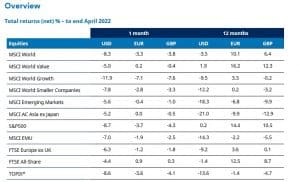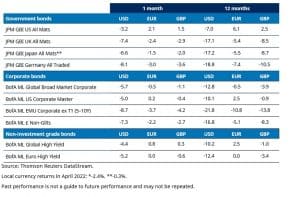A look back at markets in April, which saw a shift in interest rate expectations with markets now expecting faster rate rises.
The month in summary:
Equity markets saw further falls in April. Global shares were hit by the ongoing war in Ukraine, lockdowns in China, continued supply chain disruptions, and expectations that US interest rates could rise swiftly. US shares were sharply lower after disappointing updates from some previously fast-growing companies. Bond yields continued to rise (meaning prices moved lower) as markets anticipated significant interest rate hikes.
US
US equities fell sharply in April. Economic data showed signs of weakening while inflationary pressures continued to prompt the Federal Reserve (Fed) into a more aggressive path of interest rate hikes. Several high-profile US tech firms were notably weaker on supply-chain concerns and lacklustre results.
Inflation – as measured by headline CPI – increased 1.2% over the month of March, a sharp pick-up from February. This took the annual rate of inflation to 8.5% from 7.9%, its highest since December 1981. Higher fuel prices contributed significantly to the elevated number.
The Fed signalled a 50 basis point hike would take place in May in a step up in the central bank’s inflationary countermeasures. Meanwhile, industrial activity was broadly weaker, consumer confidence down, and initial data showed a contraction of GDP in Q1.
Weakness was widespread. Consumer staples were more resilient, while most other sectors declined. Consumer discretionary companies, unsurprisingly given the damage to consumer confidence, were amongst the weakest over the month. Car manufacturers were especially hard-hit. Communication services also declined. Netflix, notably, fell sharply after its net loss of subscribers in Q1, the first quarterly decline in users since 2007.
Eurozone
April saw further declines for eurozone equities as the war in Ukraine continued and there was no let up in inflationary pressures. Annual eurozone inflation reached 7.5% in April, up from 7.4% in March. Russia halted gas supplies to Poland and Bulgaria after the two countries refused to comply with a decree from Russia that payment must be made in roubles.
The best performing sectors included energy, amid ongoing strong demand, and communication services, where telecoms stocks fared well given their defensive profile. Information technology, consumer discretionary and industrials were the weakest sectors. Companies in these sectors tend to be among the most affected by supply chain disruptions and concerns over consumer confidence.
The eurozone economy grew by 0.2% quarter-on-quarter on Q1 and the unemployment rate dipped in February to 6.8%, from 6.9% in January. Forward-looking indicators painted a mixed picture: the services purchasing managers index (PMI) hit an eight-month high amid an upturn in tourism, but manufacturing PMI reached a 22-month low. (The PMI indices, produced by IHS Markit, are based on survey data from companies in the manufacturing and services sectors.)
As expected, Emmanuel Macron won the French presidential election.
UK
April was another marginally positive month for UK equities. The FTSE 100 index remains one of the few key national benchmarks in positive territory for 2022 in the year to date (local currency terms).
Typically defensive groups provided most of the impetus for the market, notably the pharmaceutical and the consumer staple sectors. Many of these companies are also big dollar earners and received additional support from the strength of the US currency, especially versus a weak sterling. Dollar strength also benefited the energy companies while utilities were in demand given their expected resilience to stagflation, being the combination of slowing growth and accelerating inflation.
Sterling performed poorly amid fears around the domestic economic outlook. Official data showed the UK economy slowed more sharply than expected in February, when monthly GDP rose by 0.1%, from 0.8% in January. Meanwhile, the annual rate of UK consumer inflation climbed to 7.0% in March from 6.2% in February (consumer price index), its highest since March 1992.
The same fears around the domestic outlook also weighed on domestically focused sectors and UK small and mid cap equities underperformed as a result. Consumer-facing companies in particular struggled in the face of cost of living concerns, which have raised questions around the ability of some companies to pass on their own rising costs.
Japan
After initial weakness, the Japanese stock market drifted sideways to end April 2.4% lower. The yen again weakened sharply against the US dollar in April, breaching the 130 level for the first time in 20 years.
Aside from the ongoing human tragedy unfolding in Ukraine, Japan’s equity market in April was primarily driven by news flow on monetary policy and currency markets. Comments from the US Federal Reserve pointed to a widening interest rate differential with Japan materialising earlier than expected. This view was reinforced by the results of the Bank of Japan’s (BoJ) own policy meeting on 18 April, confirming no change in policy and the maintenance of the existing target of +/– 25bps for the 10-year bond yield.
However, there was some surprise in the degree of commitment to this target shown by BoJ Governor Kuroda. Until the last two months these operations had been extremely rare, and generally only deployed at specific moments of significant market stress. However, Mr Kuroda stated that these fixed-rate operations will be conducted every day throughout May, virtually guaranteeing no rise in bond yields, which quickly pushed the yen down though the psychological 130 level against the US dollar.
On the corporate front, corporate results announcements began in late April for the fiscal year ended in March. The bulk of companies, however, will report in May, after the Golden Week holiday period.
Asia (ex Japan)
Asia ex Japan equities were lower in April as China struggled to contain its worst outbreak of Covid-19. This prompted fears that the subsequent economic stoppages could have a wider impact on the global economy and exacerbate the global supply chain shortages. Shanghai, China’s largest city and home to almost 25 million people, has been in lockdown since the end of March when cases of the Omicron variant started spiking.
Expectations of higher interest rates and the ongoing Russian invasion of Ukraine also weakened investor sentiment during a volatile trading month.
Taiwan was the worst-performing index market during April, with major electronics manufacturers and chip makers slumping due to supply chain disruptions amid the lockdowns in Shanghai and neighbouring cities. Share prices were also sharply lower in the Philippines, South Korea and Singapore in April, while share price declines in China and Hong Kong were less muted.
Indonesia was the only market in the index to end the month in positive territory after ratings agency S&P upgraded the country’s outlook to stable from negative, citing the improvement in Indonesia’s fiscal position.
Emerging markets
Emerging market (EM) equities were firmly down in April, amid a pick-up in risk aversion globally. Increasingly hawkish sentiment from the US Federal Reserve, US dollar strength, concern over the impact of Covid lockdowns in China, and Russia’s ongoing war in Ukraine all weighed on the outlook. Poland, which saw its gas supply from Russia cut off, was the weakest market in the index, while neighbouring Hungary also lagged.
Industrial metals sold off amid increased uncertainty over the demand outlook from China, which was negative for net exporters Peru, Brazil and South Arica. In Peru, protests in response to soaring food and energy inflation, also weighed on the outlook. Mexico underperformed as the cyclical outlook deteriorated and policy concerns returned, while a weaker outlook for global trade was negative for Taiwan and South Korea.
By contrast, Turkey generated a positive return and was the best-performing index market. Net energy exporters Saudi Arabia, Qatar and Kuwait also finished in positive territory. China outperformed but posted a negative return as concern over the growth outlook increased and lockdowns implied supply chain disruption may be prolonged. This was despite some modest monetary easing during the month.
Global bonds
Bond yields continued to rise in April, resulting in further negative returns (yields and prices move in opposite directions), amid continued high inflation and expectations of significant interest rate hikes.
Investors continued to weigh up the uncertainty of the war in Ukraine and the resulting disruption to supply chains. Concerns over the global growth outlook have begun to mount too, with China maintaining stringent lockdowns to tackle Covid-19.
US consumer price inflation accelerated to 8.5% year-on-year in March though the core personal consumption expenditure index fell marginally to an annualised 5.2%, from 5.3%.
The Fed maintained a hawkish stance. Policy minutes indicated it is considering a relatively quick reduction in its balance sheet. Later in the month, Fed Chair Jay Powell signalled a potential 0.5% rate increase in May.
The US 10-year Treasury yield increased from 2.35% to 2.94% and the two-year from 2.33% to 2.73%. The two to 10-year yield curve (two-year minus 10-year yield) inverted briefly early in the month.
The UK 10-year yield rose from 1.61% to 1.91% and the two-year increased from 1.36% to 1.61%. Bank of England (BoE) Governor Andrew Bailey acknowledged UK policymakers are walking a “tightrope” between inflation and the danger of the shock to household incomes that higher interest rates could represent.
In Europe, the German 10-year yield rose from 0.55% to 0.94% and the Italian 10-year yield rose from 2.04% to 2.77%. Europe saw continued surging inflation and speculation around monetary tightening. European Central Bank President Christine Lagarde repeated the message that asset purchases will end early in Q3 and rates could rise this year, but the governing council will maintain “optionality”.
Corporate bonds saw negative total returns and underperformed government bonds. High yield saw the more significant spread widening though spreads remained below the highs seen earlier this year. (Investment grade bonds are the highest quality bonds as determined by a credit rating agency; high yield bonds are more speculative, with a credit rating below investment grade).
Emerging market (EM) bonds saw negative returns too, particularly sovereign debt, while corporate credit was more resilient. EM currencies weakened as the US dollar performed strongly, particularly in Latin America and central and eastern Europe. The Chinese yuan also declined notably.
Convertible bonds re-found some of their traditional protective qualities in April. The Refinitiv Global Focus convertible bond index shed -4.1% in US dollar terms, implying downside protection of c.50% compared to the MSCI World’s fall of c.8%. New issuance of convertible bonds remains lacklustre with a volume of just over US$10 billion since the start of the year. This compares to a volume of more than US$60 billion for the same period last year.
Commodities
The S&P GSCI Index achieved a positive return in April as higher prices in the agriculture and energy components offset weaker prices for industrial metals, livestock and precious metals. Energy was the best performing component of the index during the month amid rising demand, as the global economy normalises after the Covid-19 crisis, and supply curbs due to geopolitical issues such as Russia’s ongoing invasion of Ukraine.
Within the agriculture component, prices for corn and wheat were sharply higher on continuing fears that the ongoing war between Russia and Ukraine could hinder supplies (Russia and Ukraine account for around 30% of global wheat exports).
In industrial metals, the price of aluminium was sharply lower in April. Copper and lead also saw significant price declines in the month, while price falls for nickel and zinc were more muted. Within precious metals, the price of silver was significantly lower in April, while the decline in the price of gold was less pronounced.
The value of investments and the income from them may go down as well as up and investors may not get back the amounts originally invested.


AUTHOR: Schroders – https://www.schroders.com/en/au/individuals/insights/investment-insights/monthly-markets-review—april-2022/